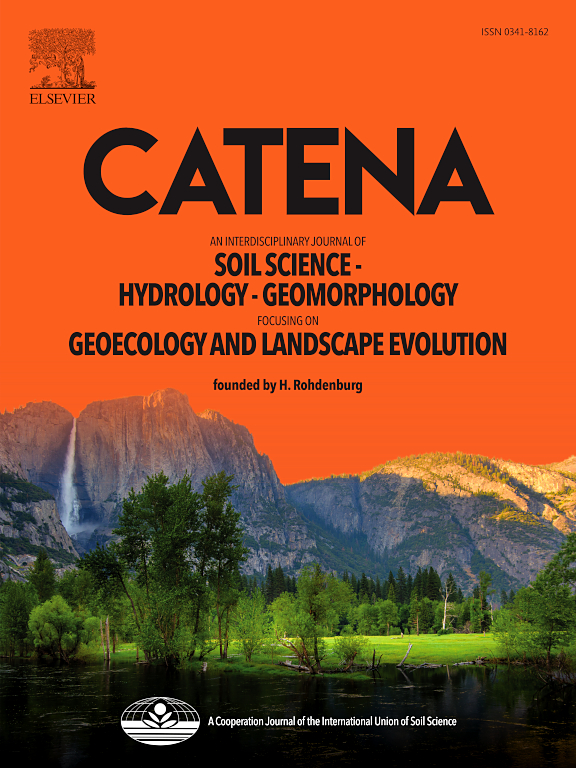Enhanced climate control on carbon accumulation dynamics in Sihe peatland, Northeast China, over the past 2200 years
IF 5.4
1区 农林科学
Q1 GEOSCIENCES, MULTIDISCIPLINARY
引用次数: 0
Abstract
Peatlands are vital terrestrial carbon sinks because of their exceptional carbon sequestration capacity. Understanding the processes and factors influencing carbon accumulation is critical for elucidating the principles governing peatland carbon dynamics, thereby supporting global climate change mitigation efforts. This study reconstructed the carbon accumulation history of the Sihe (SH) peatland, a minerotrophic fen in the Changbai Mountains of northeastern China, over the past 2200 years. Carbon stable isotopes (δ13C) of α-cellulose in Carex spp. and grain-size-sensitive components were identified as effective indicators of peatland moisture and hydrological conditions, whereas plant macrofossil analysis was performed to track the temporal changes in vegetation composition. The results indicated that the moisture condition and hydrological supply in the SH peatland have exhibited a declining trend over the past 2200 years, reflecting a strong sensitivity to centennial-scale variations in precipitation and humidity within the Changbai Mountains. During the Roman Warm Period (RWP) and the Dark Age Cold Period (DACP), despite higher summer solar insolation, greater seasonality, elevated regional temperatures, and abundant precipitation, the CAR in the SH peatland remained relatively low. This suggested that the influence of climate on CAR was constrained by other factors. During the Medieval Warm Period (MWP) and Little Ice Age (LIA), climate had a pronounced impact on CAR. Under warm and humid conditions, peatlands exhibited an elevated CAR, whereas the cold and arid conditions of the LIA led to a significant decline. Notably, the CAR of the SH peatland demonstrated no significant response to local moisture, indicating a complex relationship between hydrological conditions and carbon accumulation dynamics. This study emphasized that climate could not always be the primary driver of CAR in peatlands, with vegetation composition and local autogenic processes playing critical roles. However, the influence of climate on carbon accumulation dynamics may intensify as the peat layers accumulate.
近2200年来气候调控对东北四河泥炭地碳积累动态的影响
泥炭地具有特殊的固碳能力,是陆地上至关重要的碳汇。了解影响碳积累的过程和因素对于阐明泥炭地碳动态的支配原则至关重要,从而支持全球减缓气候变化的努力。研究重建了长白山四河泥炭地2200年来的碳积累历史。研究结果表明,Carex spp. α-纤维素的碳稳定同位素δ13C和粒度敏感组分是泥炭地水分和水文条件的有效指标,而植物大化石分析可以追踪植被组成的时间变化。结果表明:近2200年来,SH泥炭地的水汽条件和水文供给呈下降趋势,反映了长白山地区对降水和湿度的百年尺度变化具有较强的敏感性。在罗马暖期(RWP)和黑暗冷期(DACP)期间,尽管夏季太阳日晒量增加,季节性增强,区域温度升高,降水丰富,但SH泥炭地的CAR仍然相对较低。这表明气候对CAR的影响受到其他因素的制约。在中世纪暖期(MWP)和小冰期(LIA)期间,气候对CAR的影响显著。在温暖湿润条件下,泥炭地的CAR升高,而在寒冷干旱的LIA条件下,CAR显著下降。值得注意的是,SH泥炭地的CAR对当地湿度没有显著响应,表明水文条件与碳积累动态之间存在复杂的关系。本研究强调气候并不总是泥炭地CAR的主要驱动因素,植被组成和局部自生过程起着关键作用。然而,随着泥炭层的积累,气候对碳积累动态的影响可能会加剧。
本文章由计算机程序翻译,如有差异,请以英文原文为准。
求助全文
约1分钟内获得全文
求助全文
来源期刊

Catena
环境科学-地球科学综合
CiteScore
10.50
自引率
9.70%
发文量
816
审稿时长
54 days
期刊介绍:
Catena publishes papers describing original field and laboratory investigations and reviews on geoecology and landscape evolution with emphasis on interdisciplinary aspects of soil science, hydrology and geomorphology. It aims to disseminate new knowledge and foster better understanding of the physical environment, of evolutionary sequences that have resulted in past and current landscapes, and of the natural processes that are likely to determine the fate of our terrestrial environment.
Papers within any one of the above topics are welcome provided they are of sufficiently wide interest and relevance.
 求助内容:
求助内容: 应助结果提醒方式:
应助结果提醒方式:


